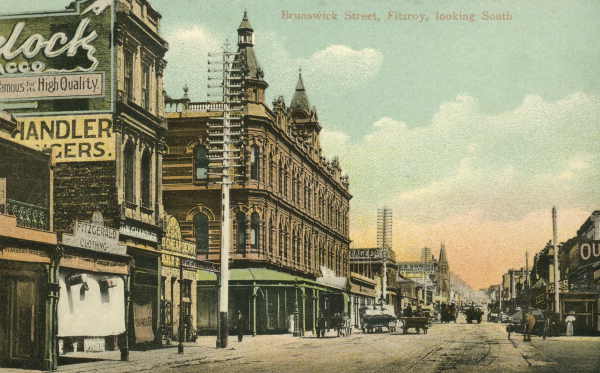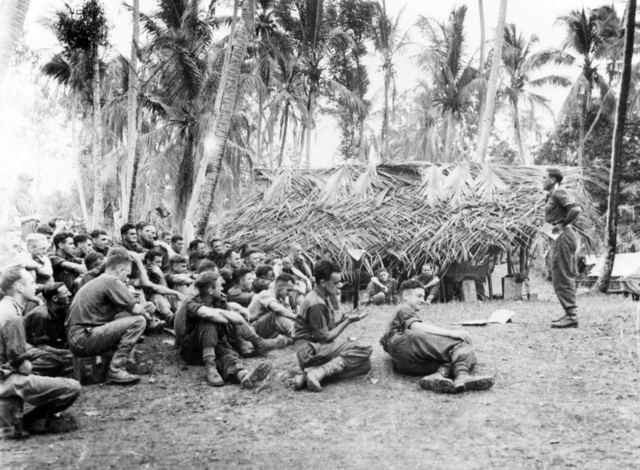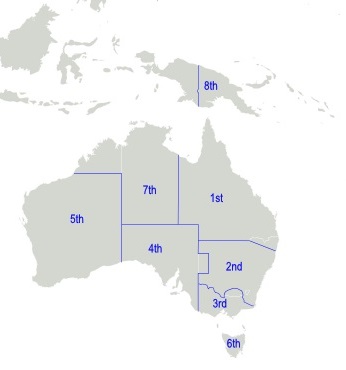|
Victor Stantke
Major General Victor Paul Hildebrandt Stantke, (15 August 1886 – 1967) was a senior officer in the Australian Army, serving during the First World War and Second World War. His appointments were mainly to staff and administrative postings, including holding the position of Adjutant-General from 1940 to 1943, and commander Queensland Lines of Communication Area from 1943 to 1946. Early life and First World War Stantke was born in Fitzroy, Victoria, on 15 August 1886. Educated at the University of Melbourne, he served in the Australian Military Forces as a senior cadet from 1906, and was commissioned through this scheme, reaching the rank of captain by 1909. However, after working as teacher at Brighton Grammar School, in 1911 he relinquished his previous rank and joined the Permanent Military Forces. In the Permanent Force, he was appointed to the Administrative and Instructional Staff (A & I Staff), as a lieutenant, before transferring to the Australian Imperial Force (AIF ... [...More Info...] [...Related Items...] OR: [Wikipedia] [Google] [Baidu] |
Fitzroy, Victoria
Fitzroy is an inner-city suburb in Melbourne, Victoria, Australia, north-east of Melbourne's Central Business District, located within the City of Yarra local government area. Fitzroy recorded a population of 10,431 at the 2021 census. Planned as Melbourne's first suburb in 1839, it later became one of the city's first areas to gain municipal status, in 1858. It occupies Melbourne's smallest and most densely populated area outside the CBD, just 100 ha. Fitzroy is known as a cultural hub, particularly for its live music scene and street art, and is the main home of the Melbourne Fringe Festival. Its commercial heart is Brunswick Street, one of Melbourne's major retail, culinary, and nightlife strips. Long associated with the working class, Fitzroy has undergone waves of urban renewal and gentrification since the 1980s and today is home to a wide variety of socio-economic groups, featuring both some of the most expensive rents in Melbourne and one of its largest public hou ... [...More Info...] [...Related Items...] OR: [Wikipedia] [Google] [Baidu] |
Western Front (World War I)
The Western Front was one of the main theatres of war during the First World War. Following the outbreak of war in August 1914, the German Army opened the Western Front by invading Luxembourg and Belgium, then gaining military control of important industrial regions in France. The German advance was halted with the Battle of the Marne. Following the Race to the Sea, both sides dug in along a meandering line of fortified trenches, stretching from the North Sea to the Swiss frontier with France, which changed little except during early 1917 and in 1918. Between 1915 and 1917 there were several offensives along this front. The attacks employed massive artillery bombardments and massed infantry advances. Entrenchments, machine gun emplacements, barbed wire and artillery repeatedly inflicted severe casualties during attacks and counter-attacks and no significant advances were made. Among the most costly of these offensives were the Battle of Verdun, in 1916, with a combined 700,000 ... [...More Info...] [...Related Items...] OR: [Wikipedia] [Google] [Baidu] |
Thomas Blamey
Field marshal (Australia), Field Marshal Sir Thomas Albert Blamey, (24 January 1884 – 27 May 1951) was an Australian general of the First World War, First and Second World Wars, and the only Australian to attain the rank of field marshal. Blamey joined the Australian Army as a regular soldier in 1906, and attended the Pakistan Command and Staff College, Staff College at Quetta. During the First World War he participated in the landing at Anzac Cove on 25 April 1915, and served as a staff officer in the Gallipoli Campaign, where he was mentioned in despatches for a daring raid behind enemy lines. He later served on the Western Front (World War I), Western Front, where he distinguished himself in the planning for the Battle of Pozières. He rose to the rank of brigadier general, and served as chief of staff of the Australian Corps under Lieutenant general (Australia), Lieutenant General Sir John Monash, who credited him as a factor in the Corps' success in the Battle of Hamel, t ... [...More Info...] [...Related Items...] OR: [Wikipedia] [Google] [Baidu] |
Royal Australian Army Educational Corps
The Royal Australian Army Educational Corps (RAAEC) is a specialist corps within the Australian Army. Formed in 1949, the corps had its genesis in other services that existed within the Australian forces during World War I and World War II. It is currently made up entirely of commissioned officers and is responsible for the provision of education-related services within the Army. Its various roles include instruction, designing computer-based learning materials, instructional systems, language training, literacy, and numeracy. History The RAAEC was established in September 1949 as the Australian Army Educational Corps and was granted Royal assent in 1960.Dennis et al 1995, p. 513. Consisting of the Crown and a boomerang upon which the corps' initials are inscribed superimposed over a "fluted flambeau of flames", the current RAAEC corps badge was adopted in 1964. It is the only corps badge in the Australian Army where the crown does not appear at the top and is based on the badge d ... [...More Info...] [...Related Items...] OR: [Wikipedia] [Google] [Baidu] |
Directorate Of Research And Civil Affairs
The Directorate of Research and Civil Affairs (DORCA) was a mysterious and difficult-to-categorise think tank and possibly intelligence organisation within the Australian Army during World War II. Set up and headed by the charismatic Alf Conlon, the Directorate's alumni had a huge influence over Australia and the Pacific region post-WWII, especially through the Australian School of Pacific Administration (ASOPA). DORCA has been described as mysterious, odd ball, bohemian. It is difficult, if not impossible to categorise, having clearly involved at least in some sense in intelligence work. That it morphed into ASOPA after the war gives no real insight into its wartime activities. When formed in February 1943, the Directorate was made part of Military Intelligence, with Conlon reporting directly to General Blamey, commander-in-chief of the Australian Military Forces.Pybus, Cassandra 2012''Conlon’s Remarkable Circus'' in Some of the work achieved during its short, wartime life ... [...More Info...] [...Related Items...] OR: [Wikipedia] [Google] [Baidu] |
Brigadier
Brigadier is a military rank, the seniority of which depends on the country. In some countries, it is a senior rank above colonel, equivalent to a brigadier general or commodore, typically commanding a brigade of several thousand soldiers. In other countries, it is a non-commissioned rank. Origins and history The word and rank of "Brigadier" originates from France. In the French Army, the Brigadier des Armées du Roi (Brigadier of the King's Armies) was a general officer rank, created in 1657. It was an intermediate between the rank of Mestre de camp and that of Maréchal de camp. The rank was first created in the cavalry at the instigation of Marshal Turenne on June 8, 1657, then in the infantry on March 17, 1668, and in the dragoons on April 15, 1672. In peacetime, the brigadier commanded his regiment and, in maneuvers or in wartime, he commanded two or three - or even four - regiments combined to form a brigade (including his own, but later the rank was also awarded to l ... [...More Info...] [...Related Items...] OR: [Wikipedia] [Google] [Baidu] |
Colonel
Colonel (abbreviated as Col., Col or COL) is a senior military officer rank used in many countries. It is also used in some police forces and paramilitary organizations. In the 17th, 18th and 19th centuries, a colonel was typically in charge of a regiment in an army. Modern usage varies greatly, and in some cases, the term is used as an honorific title that may have no direct relationship to military service. The rank of colonel is typically above the rank of lieutenant colonel. The rank above colonel is typically called brigadier, brigade general or brigadier general. In some smaller military forces, such as those of Monaco or the Vatican, colonel is the highest rank. Equivalent naval ranks may be called captain or ship-of-the-line captain. In the Commonwealth's air force ranking system, the equivalent rank is group captain. History and origins By the end of the late medieval period, a group of "companies" was referred to as a "column" of an army. According to Raymond Ol ... [...More Info...] [...Related Items...] OR: [Wikipedia] [Google] [Baidu] |
2nd Military District (Australia)
The 2nd Military District was an administrative district of the Australian Army that covered most of New South Wales, with its headquarters in Sydney. The southern border with the 3rd Military District was the Murrumbidgee River rather than the Murray River, and the western part of the state around Broken Hill was part of the 4th Military District. In March 1939 a regional command structure was adopted, with 2nd Military District becoming Eastern Command and the 5th Military District was redesignated Western Command, while the 1st Military District in Queensland became Northern Command, and the three southern districts, the 3rd, 4th and 6th Military Districts in Victoria, South Australia and Tasmania, were amalgamated into Southern Command. This required legislative changes to the ''Defence Act'' (1903), and did not come into effect until October 1939. See also * Proposed Japanese invasion of Australia during World War II Notes References * * {{cite book, last=Long, fir ... [...More Info...] [...Related Items...] OR: [Wikipedia] [Google] [Baidu] |
4th Military District (Australia)
The 4th Military District was an administrative district of the Australian Army. During the Second World War, the 4th Military District covered all of South Australia, with its headquarters at Adelaide. Around the start of the Second World War, the 4th Military District became part of Southern Command, along with the 3rd and 6th Military Districts in Victoria and Tasmania. This required legislative changes to the ''Defence Act'' (1903), and did not come into effect until October 1939. Units during Second World War Headquarters *4th Military District Headquarters – Adelaide 6th Cavalry Brigade *Headquarters – Keswick * 3rd Light Horse Regiment (The South Australian Mounted Rifles) – Mt. Gambier * 9th/23rd Light Horse Regiment (Flinders Light Horse/Barossa Light Horse) – Clare *18th Light Horse (Machine Gun) Regiment (The Adelaide Lancers) – Unley 3rd Infantry Brigade *Headquarters – Keswick * 10th Battalion (The Adelaide Rifles) – Adelaide * 27th Battalion (The Sout ... [...More Info...] [...Related Items...] OR: [Wikipedia] [Google] [Baidu] |
Senior Officers' School
The Senior Officers' School was a British military establishment established in 1916 by Brigadier-General R.J. Kentish for the training of Commonwealth senior officers of all services in inter-service cooperation. It was established as part of a wider attempt by the British Army to create a coherent training plan for its officers. History The School was originally intended for senior officers of the British Army who aspired to battalion command. It was taken as an affront by some senior officers of the day, who resented the implication—true in some cases—that they were incapable of delivering the necessary training. The School attempted to widen officers' outlook by including in its syllabus subjects that were not immediately military but led to an appreciation of the wider political, geographical and technological environment in which the British Army would operate. The School was originally based at Aldershot but in the 1920s, it was transferred to Sheerness. In 1939 it mo ... [...More Info...] [...Related Items...] OR: [Wikipedia] [Google] [Baidu] |
Officer Of The Order Of The British Empire
The Most Excellent Order of the British Empire is a British order of chivalry, rewarding contributions to the arts and sciences, work with charitable and welfare organisations, and public service outside the civil service. It was established on 4 June 1917 by King George V and comprises five classes across both civil and military divisions, the most senior two of which make the recipient either a knight if male or dame if female. There is also the related British Empire Medal, whose recipients are affiliated with, but not members of, the order. Recommendations for appointments to the Order of the British Empire were originally made on the nomination of the United Kingdom, the self-governing Dominions of the Empire (later Commonwealth) and the Viceroy of India. Nominations continue today from Commonwealth countries that participate in recommending British honours. Most Commonwealth countries ceased recommendations for appointments to the Order of the British Empire when they cre ... [...More Info...] [...Related Items...] OR: [Wikipedia] [Google] [Baidu] |
Lieutenant Colonel
Lieutenant colonel ( , ) is a rank of commissioned officers in the armies, most marine forces and some air forces of the world, above a major and below a colonel. Several police forces in the United States use the rank of lieutenant colonel. The rank of lieutenant colonel is often shortened to simply "colonel" in conversation and in unofficial correspondence. Sometimes, the term 'half-colonel' is used in casual conversation in the British Army. In the United States Air Force, the term 'light bird' or 'light bird colonel' (as opposed to a 'full bird colonel') is an acceptable casual reference to the rank but is never used directly towards the rank holder. A lieutenant colonel is typically in charge of a battalion or regiment in the army. The following articles deal with the rank of lieutenant colonel: * Lieutenant-colonel (Canada) * Lieutenant colonel (Eastern Europe) * Lieutenant colonel (Turkey) * Lieutenant colonel (Sri Lanka) * Lieutenant colonel (United Kingdom) * L ... [...More Info...] [...Related Items...] OR: [Wikipedia] [Google] [Baidu] |



